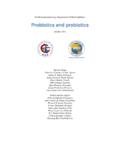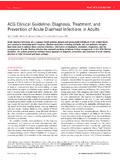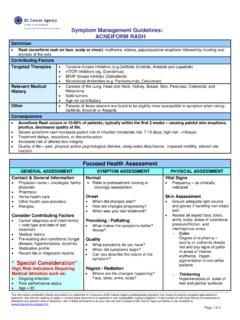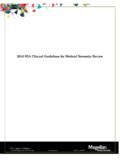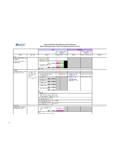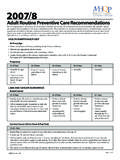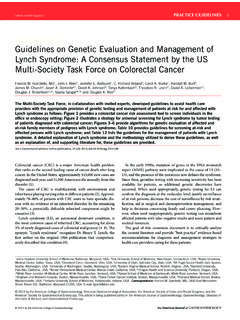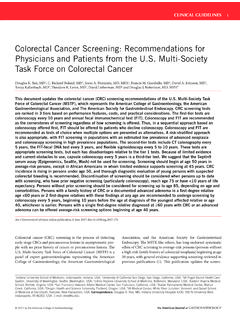Transcription of Guidelines for the management of iron deficiency …
1 Guidelines for the management of irondeficiency anaemiaAndrew F Goddard,1 Martin W James,2 Alistair S McIntyre,3 Brian B Scott,4onbehalf of the British Society of GastroenterologyABSTRACTB ackground< iron deficiency anaemia (IDA) occurs in 2e5% of adultmen and postmenopausal women in the developedworld and is a common cause of referral togastroenterologists. Gastrointestinal (GI) blood lossfrom colonic cancer or gastric cancer, and malab-sorption in coeliac disease are the most importantcauses that need to be iron deficiency anaemia <The lower limit of the normal range for the laboratoryperforming the test should be used to define anaemia (B).
2 <Any level of anaemia should be investigated in thepresence of iron deficiency (B).<The lower the haemoglobin the more likely there is tobe serious underlying pathology and the more urgentis the need for investigation (B).<Red cell indices provide a sensitive indication of irondeficiency in the absence of chronic disease orhaemoglobinopathy (A).<Haemoglobin electrophoresis is recommended whenmicrocytosis and hypochromia are present in patientsof appropriate ethnic background to prevent unnec-essary GI investigation (C).<Serum ferritin is the most powerful test for irondeficiency (A).
3 Investigations<Upper and lower GI investigations should be consideredin all postmenopausal female and all male patientswhere IDA has been confirmed unless there is a historyof significant overt non-GI blood loss (A).<All patients should be screened for coeliac disease (B).<If oesophagogastroduodenoscopy (OGD) is performedas the initial GI investigation, only the presence ofadvanced gastric cancer or coeliac disease shoulddeter lower GI investigation (B).<In patients aged>50 or with marked anaemia ora significant family history of colorectal carcinoma,lower GI investigation should still be considered even ifcoeliac disease is found (B).
4 <Colonoscopy has advantages over CT colography forinvestigation of the lower GI tract in IDA, but either isacceptable (B). Either is preferable to barium enema,which is useful if they are not available.<Further direct visualisation of the small bowel is notnecessary unless there are symptoms suggestive ofsmall bowel disease, or if the haemoglobin cannot berestored or maintained with iron therapy (B).<In patients with recurrent IDA and normal OGD andcolonoscopy results,Helicobacter pylorishould beeradicated if present. (C).
5 <Faecal occult blood testing is of no benefit in theinvestigation of IDA (B).<All premenopausal women with IDA should bescreened for coeliac disease, but other upper andlower GI investigation should be reserved for thoseaged 50 years or older, those with symptomssuggesting gastrointestinal disease, and those witha strong family history of colorectal cancer (B).<Upper and lower GI investigation of IDA in post-gastrectomy patients is recommended in those over50 years of age (B).<In patients with iron deficiency without anaemia ,endoscopic investigation rarely detects investigation should be considered in patientsaged>50 after discussing the risk and potentialbenefit with them (C).
6 <Only postmenopausal women and men aged>50 years should have GI investigation of irondeficiency without anaemia (C).<Rectal examination is seldom contributory, and, in theabsence of symptoms such as rectal bleeding andtenesmus, may be postponed until colonoscopy.<Urine testing for blood is important in the examinationof patients with IDA (B). management <All patients should have iron supplementation both tocorrect anaemia and replenish body stores (B).<Parenteral iron can be used when oral preparations arenot tolerated (C).
7 <Blood transfusions should be reserved for patientswith or at risk of cardiovascular instability due to thedegree of their anaemia (C).SCOPET hese Guidelines are primarily intended for Westerngastroenterologists and gastrointestinal (GI)surgeons, but are applicable for other doctors seeingpatients with iron deficiency anaemia (IDA). Theyare not designed to cover patients with overt bloodloss or those who present with GI symptoms. GIsymptoms or patients at particular risk of GIdisease should be investigated on their own occurs in 2e5% of adult men and post-menopausal women in the developed world12andis a common cause of referral to gastroenterologists(4e13% of referrals).
8 3 While menstrual blood loss isthe most common cause of IDA in premenopausalwomen, blood loss from the GI tract is the mostcommon cause in adult men and colonic and gastriccarcinoma may present with IDA, and seekingthese conditions is a priority in patients with (most commonly from coeliacdisease in the UK), poor dietary intake, blooddonation, gastrectomy and use of non-steroidal1 Digestive Diseases Centre,Royal Derby Hospital, Derby, UK2 Nottingham Digestive DiseasesCentre, NIHR BiomedicalResearch Unit, Nottingham, UK3 Department ofGastroenterology, WycombeHospital, High Wycombe, UK4 Department ofGastroenterology, LincolnCounty Hospital, Lincoln, UKCorrespondence toBrian B Scott, Department ofMedicine, Lincoln CountyHospital, Lincoln LN2 5QY.
9 28 September 2010 Accepted 20 March 2011 Published Online First11 May 2011 Gut2011;60:1309e1316. drugs (NSAIDs) are common causes of IDA,and there are many other possible causes (table 1). IDA is oftenmultifactorial. Its management is often suboptimal, with mostpatients being incompletely investigated or not investigated 11 Dual pathologydthat is, the presence of a significantcause of bleeding in both upper and lower GI tractsdmay occurin 1e10% of patients or more4e9and should be increasinglyconsidered the older the IDAA naemiaThe World Health Organization defines anaemia as a haemo-globin (Hb)
10 Concentration below 13 g/dl in men over 15 years ofage, below 12 g/dl in non-pregnant women over 15 years of age,and below 11 g/dl in pregnant diagnostic criteriafor anaemia in IDA vary between published range for Hb also varies between different populations inthe UK. Therefore it is reasonable to use the lower limit of thenormal range for the laboratory performing the test to defineanaemia (B).There is little consensus as to the level of anaemia thatrequires investigation. The NHS National Institute for Health andClinical Excellence referral Guidelines for suspected lower GIcancer suggest that only patients with Hb concentration<11 g/dlin men or<10 g/dl in non-menstruating women be been suggested that these cut-off values miss patients withcolorectal cancer, especially is therefore recommendedthat any level of anaemia should be investigated in the presenceof iron deficiency.
